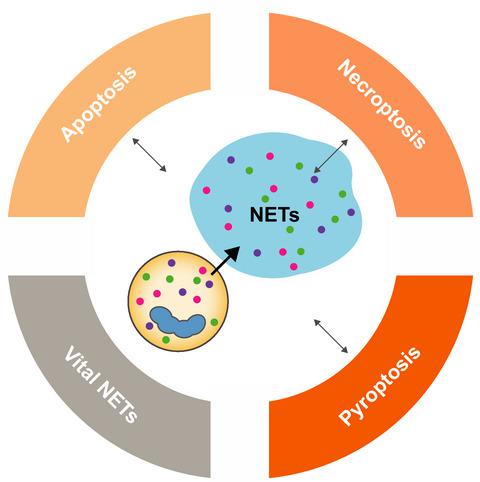Our official English website, www.x-mol.net, welcomes your feedback! (Note: you will need to create a separate account there.)
NET formation – mechanisms and how they relate to other cell death pathways
The FEBS Journal ( IF 5.4 ) Pub Date : 2020-10-12 , DOI: 10.1111/febs.15589 Thibault Rosazza 1 , Jordan Warner 1 , Gabriel Sollberger 1
The FEBS Journal ( IF 5.4 ) Pub Date : 2020-10-12 , DOI: 10.1111/febs.15589 Thibault Rosazza 1 , Jordan Warner 1 , Gabriel Sollberger 1
Affiliation

|
Cell death is an integral part of both infectious and sterile inflammatory reactions. Many cell death pathways cause the dying cell to lyse, thereby amplifying inflammation. A special form of lytic cell death is the formation of neutrophil extracellular traps (NETs), large structures of chromatin and antimicrobial proteins, which are released by dying neutrophils to capture extracellular pathogens and limit the spread of infections. The molecular mechanisms of NET formation remain incompletely understood. Recent research demonstrated substantial crosstalk between different cell death pathways, most notably between apoptosis, pyroptosis and necroptosis. Here, we review suicidal and vital NET formation and discuss potential crosstalk of their mechanisms of release with other forms of cell death.
中文翻译:

NET 形成——机制及其与其他细胞死亡途径的关系
细胞死亡是感染性和无菌性炎症反应的组成部分。许多细胞死亡途径导致垂死细胞裂解,从而放大炎症。溶解性细胞死亡的一种特殊形式是中性粒细胞胞外陷阱 (NET)、染色质和抗菌蛋白的大型结构的形成,它们由垂死的中性粒细胞释放以捕获胞外病原体并限制感染的传播。NET 形成的分子机制仍未完全了解。最近的研究表明,不同细胞死亡途径之间存在大量串扰,最显着的是细胞凋亡、细胞焦亡和坏死性凋亡之间的串扰。在这里,我们回顾了自杀性和重要的 NET 形成,并讨论了它们的释放机制与其他形式的细胞死亡的潜在串扰。
更新日期:2020-10-12
中文翻译:

NET 形成——机制及其与其他细胞死亡途径的关系
细胞死亡是感染性和无菌性炎症反应的组成部分。许多细胞死亡途径导致垂死细胞裂解,从而放大炎症。溶解性细胞死亡的一种特殊形式是中性粒细胞胞外陷阱 (NET)、染色质和抗菌蛋白的大型结构的形成,它们由垂死的中性粒细胞释放以捕获胞外病原体并限制感染的传播。NET 形成的分子机制仍未完全了解。最近的研究表明,不同细胞死亡途径之间存在大量串扰,最显着的是细胞凋亡、细胞焦亡和坏死性凋亡之间的串扰。在这里,我们回顾了自杀性和重要的 NET 形成,并讨论了它们的释放机制与其他形式的细胞死亡的潜在串扰。

























 京公网安备 11010802027423号
京公网安备 11010802027423号